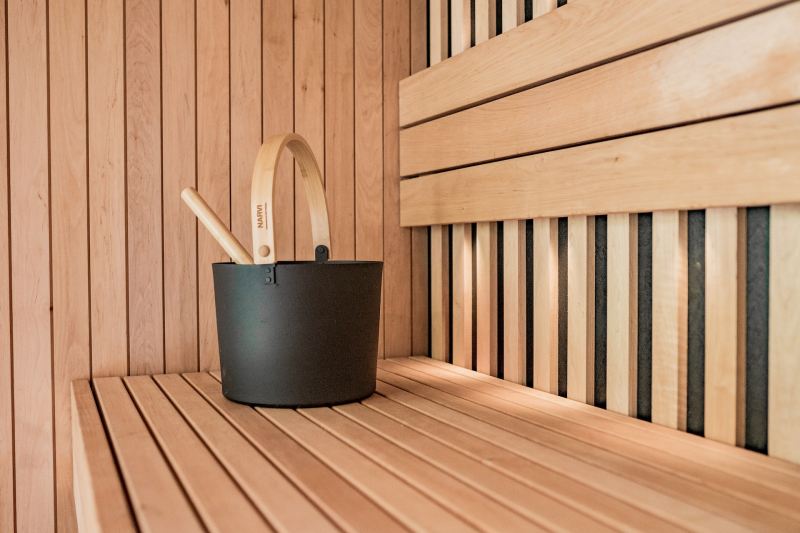
Installing a home sauna is a fantastic way to relax, unwind, and enjoy the numerous health benefits saunas offer. Whether you prefer a traditional wood-burning sauna, an electric one, or an infrared model, creating the perfect sauna experience requires careful planning and consideration.
There are various factors you need to take into account when installing a sauna in your home, from choosing the right type of sauna to ensuring compliance with building codes and permits. Here’s what you need to know to create a sauna oasis that meets your specific needs and preferences.

Things to consider when installing a sauna
Choose your preferred type of sauna
The first step in installing a sauna is deciding on the type that best suits your lifestyle and preferences. From the rustic charm of wood-burning saunas to the convenience of electric and infrared models, the one you choose will depend on how modern or traditional you want your experience to be. There are several options available, each with its own set of advantages and disadvantages:
- Traditional wood-burning sauna: The traditional (or Finnish) wood-burning sauna is a classic choice. Wood-burning saunas offer a pleasant aroma and a genuine feel, making them popular among sauna enthusiasts. However, they require a chimney and regular maintenance to ensure safe operation. Owners of traditional saunas must have easy access to firewood and water to throw on the rocks.
- Electric sauna: Electric saunas are easy to use and can be quickly heated up. They are ideal for those seeking convenience and simplicity, while still having the traditional elements of steam. Electric models also tend to be more space-efficient, making them suitable for smaller home setups.
- Infrared sauna: Infrared saunas use infrared heaters to directly heat your body, penetrating deeper into the skin compared to traditional saunas. They operate at lower temperatures and consume less energy, making them cost-effective and well-suited for those sensitive to high heat. That said, you won’t have the traditional element of steam.
Find the perfect space and location
When building an at-home sauna, plan carefully where each of the elements will go. Most kits already have designated areas for each bench and the heating unit, so be careful to follow the instructions. Before buying your sauna, take note of the dimensions and measure the area you want to place it. Nothing is worse than spending $5,000 only to realize that your sauna doesn’t fit in your home or yard. Here are a few other things to consider when thinking about where your home sauna will go:
- Good ventilation: Adequate ventilation is essential to ensure the circulation of fresh air and prevent excessive humidity buildup. If you don’t have enough, you might feel like you can’t breathe in the heat. Most kits have at least two vents, one near the roof and one along the ground. When setting up your sauna, make sure that neither of these are blocked or obscured by other objects.
- Proximity to water sources: Having your sauna near a water source makes it convenient to refill the bucket for creating steam. If this source is a lake, you will be able to cool off by swimming between sauna sessions.
- Accessibility: Choose a location that is easily accessible from other areas of your home. Ideally, it should be a place where you can transition comfortably from regular activities to relaxation.
Building codes & permits
In most regions, you will need a building permit to construct a sauna, regardless of whether it’s indoors or outdoors. This permit ensures that your sauna complies with local safety standards, which can vary from state to state. These can range from electrical permits, plumbing permits, and fire safety codes. Research your area and consult your local building department authorities to determine the specific codes and permits needed for building a sauna in your area.
Electrical requirements
For electric and infrared saunas, the electrical capabilities of your home will make or break the experience. The power supply must be adequate to handle the sauna’s electrical demand, and the wiring should be done by a qualified electrician. Safety is paramount when dealing with electricity, so never compromise on the quality of electrical work for your sauna.
Choose the best materials
In order to get the best home sauna experience, choose a kit with the highest quality materials.
- Heat-resistant flooring: Sauna floors endure high temperatures and humidity, so it’s crucial to choose a heat-resistant flooring material. Many old traditional saunas have a cement floor. Today, ceramic or porcelain tiles are popular options due to their beauty, durability, and resistance to heat.
- Sauna walls: Use wood on the walls to create an authentic and cozy atmosphere. Cedar and redwood are excellent choices because these kinds of wood have a pleasant aroma and are resistant to warping and decay.
- Sauna rocks: Are you aware that there are even different kinds of sauna rocks to choose from? Sauna rocks have to be durable, retain heat, and be porous enough to absorb water and produce steam. Basalt rocks are the most popular for electric and wood-burning saunas. Since they are formed from hardened lava, they can withstand extreme temperatures.
Equip your sauna with safety measures
Safety should be a top priority when installing a sauna in your home. Implement the following safety measures to ensure a worry-free sauna experience:
- Handrails: Install sturdy handrails on the interior walls of your sauna to provide support and stability when moving around in high heat.
- Non-slip surfaces: Choose materials like cedar or hemlock for the benches, as they naturally repel moisture and provide a non-slip surface. If you choose tile for the floor, make sure you place slip-resistant mats along the walking paths.
- Multiple bench levels: Consider installing at least two levels of benches to accommodate different seating preferences and temperature zones. Higher benches are hotter, while lower ones offer a more moderate heat.
Accessories to consider
No personal sauna is complete without a few accessories, like a thermometer. Many sauna kits come with a few of these items, but some don’t. If you have a wood-burning sauna or an electric sauna, a water spigot, bucket, and ladle is a requirement. The best place to put the spigot is inside the sauna, so you don’t even have to leave the warmth if you run out of water. Wooden pillows or backrests grant an extra level of comfort in the sauna, and to enhance your experience even further, make a sauna vihta out of birch branches.

Setting up a sauna in your home can be a rewarding project that adds value to your property and improves your wellbeing and that of your family. By choosing the right type of sauna, finding the perfect location, adhering to building codes, and selecting suitable materials and accessories, you can create a safe, functional, and inviting sauna space in your own home. Always prioritize safety and consult with professionals when needed to ensure that your sauna installation is a success.



